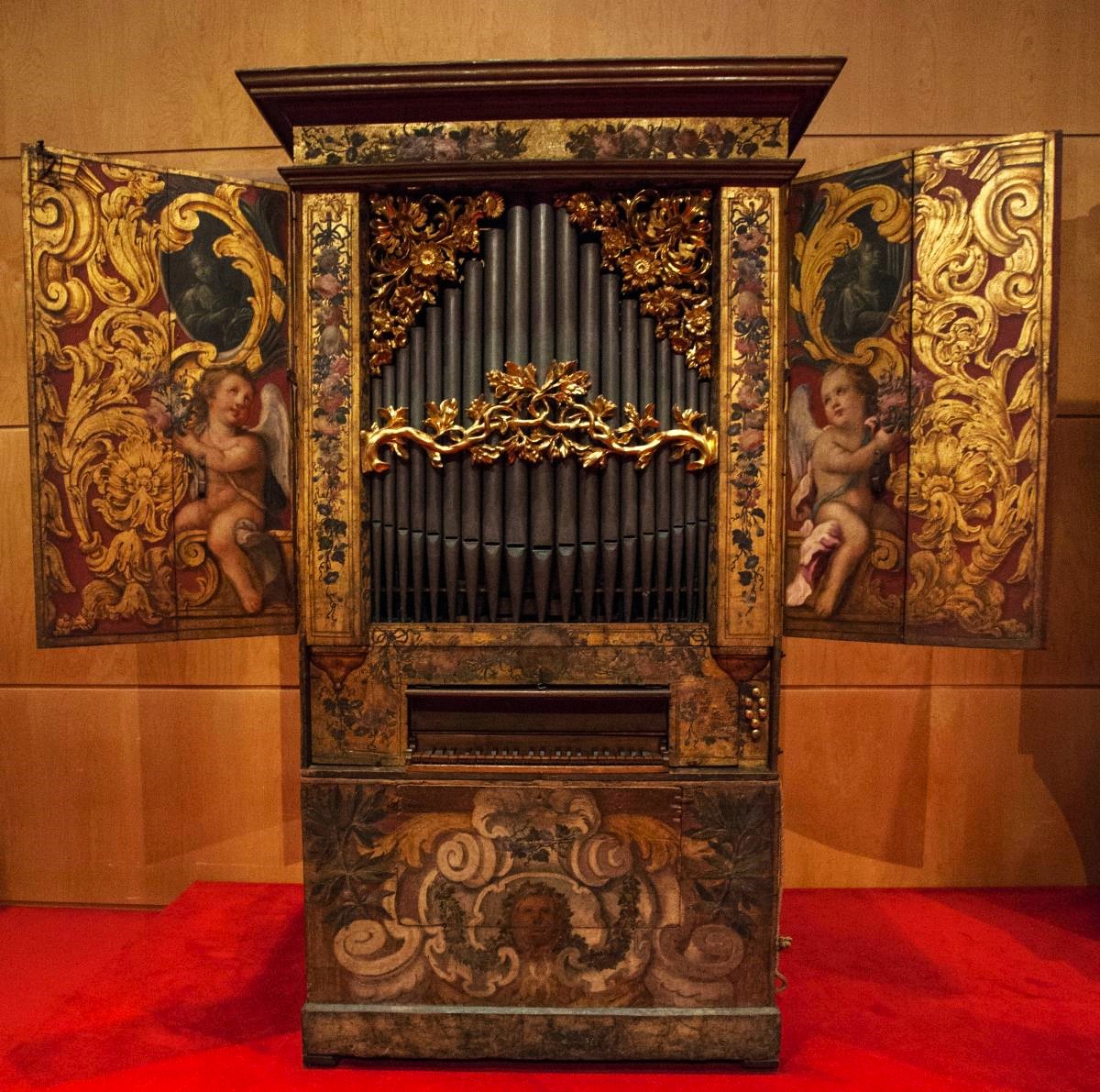Barcelona, Museu de la Música (Josep Boscà Organ)
| Builder | J. Boscà |
|---|---|
| Year | ca. 1710 |
| Period/Style | Baroque |
| Stops | 6 |
| Keyboards | 1 |
| Keyaction | tracker/mechanical |
| Sampleset |
Available
 , sampled by
Teclats.cat
, sampled by
Teclats.cat
|
This organ originated from the former convent of Santa Caterina in Barcelona and is attributed to Josep Boscà i Serinyena (?-1733), the founder of a lineage of organ builders active primarily in Barcelona and Girona between the 17th and 18th centuries. Boscà began his work on organs like those in Cadaqués and Sant Domènec de Girona in 1689. He also engaged in restoration work and constructed organs for the Barcelona Cathedral (1686-1688), Montblanc, the chapel of Sant Oleguer in Barcelona, Sant Sever, and Solsona, among others. During his later years, he built the organs for Camprodon in 1731 and Igualada in 1736, and worked at the monasteries of Montserrat and Poblet in 1732. His sons, Antoni and Josep Boscà i Llorens, continued the family tradition, constructing organs throughout Catalonia.
The organ case is made of wood and fully polychromed with floral and vegetal motifs typical of the mid-17th century Madrid school, possibly from Juan Arellano's workshop. The interior of the doors features angels holding flower bouquets and portraits of Saint Cecilia and Saint Catherine, framed with gilded vegetal designs. The facade is adorned with gilded carvings of flowers and other vegetal elements, with a mascaron and laurel crown surrounded by rocaille elements at the bottom. The keyboard consists of forty-five keys, from C1 to C6, with naturals plated with boxwood and sharps stained dark. The key fronts are decorated with concentric semicircles, and it has a short octave range: C - F - D - G - E - A - B♭ - B - C.
The organ operates with suspended mechanics, has no pedalboard, and the bellows are integrated inside, driven by pulleys and ropes. It is tuned to A at 440 Hz. The stops include full registers: an 8' flute (C1-D#2), a fixed register that always sounds; pipes located on the facade from E2; 4' octave, 2' octave, 1 1/3' nineteenth, 1' twenty-second, 2/3' twenty-sixth. The facade has nineteen pipes from E2 in the center. The order of the stops on the windchest includes thirteen wooden pipes of the 8' flute (C2-D#2) without a register, 26th, 22nd, nineteenth, fifteenth, octave (wooden basses), and 8' facade flute. The windchest is mitre-shaped with the first C at the center, and various internal parts are marked with an "R" under a crowned and crossed tiara, branded with a hot iron. The organ closely resembles one in the Barcelona Cathedral, built by Josep's son, Antoni Boscà, in 1712.
The organ case is made of wood and fully polychromed with floral and vegetal motifs typical of the mid-17th century Madrid school, possibly from Juan Arellano's workshop. The interior of the doors features angels holding flower bouquets and portraits of Saint Cecilia and Saint Catherine, framed with gilded vegetal designs. The facade is adorned with gilded carvings of flowers and other vegetal elements, with a mascaron and laurel crown surrounded by rocaille elements at the bottom. The keyboard consists of forty-five keys, from C1 to C6, with naturals plated with boxwood and sharps stained dark. The key fronts are decorated with concentric semicircles, and it has a short octave range: C - F - D - G - E - A - B♭ - B - C.
The organ operates with suspended mechanics, has no pedalboard, and the bellows are integrated inside, driven by pulleys and ropes. It is tuned to A at 440 Hz. The stops include full registers: an 8' flute (C1-D#2), a fixed register that always sounds; pipes located on the facade from E2; 4' octave, 2' octave, 1 1/3' nineteenth, 1' twenty-second, 2/3' twenty-sixth. The facade has nineteen pipes from E2 in the center. The order of the stops on the windchest includes thirteen wooden pipes of the 8' flute (C2-D#2) without a register, 26th, 22nd, nineteenth, fifteenth, octave (wooden basses), and 8' facade flute. The windchest is mitre-shaped with the first C at the center, and various internal parts are marked with an "R" under a crowned and crossed tiara, branded with a hot iron. The organ closely resembles one in the Barcelona Cathedral, built by Josep's son, Antoni Boscà, in 1712.
| Manual |
|---|
| Flautat (always on) |
| Octava |
| Quinzena |
| Dinovena |
| Vintidosena |
| Vintisisena |
Belle sans pere Libro de Cifra Nueva Alcala de Henares 1557 Luys Venegas de Henestrosa
0:00
0:00
https://www.atmos.cat/perl?num=1679785849
https://cataleg.museumusica.bcn.cat/detall/fons_instruments/H310259/
https://cataleg.museumusica.bcn.cat/detall/fons_instruments/H310259/
 Pipe Organ Map
Pipe Organ Map